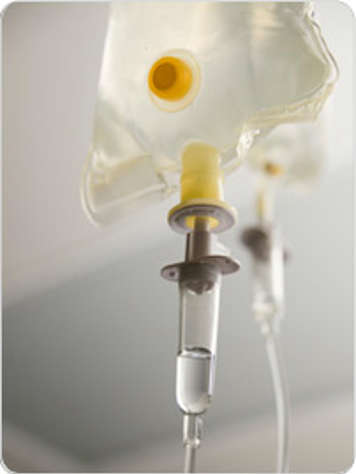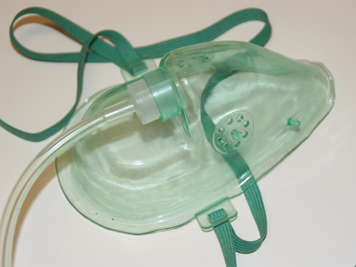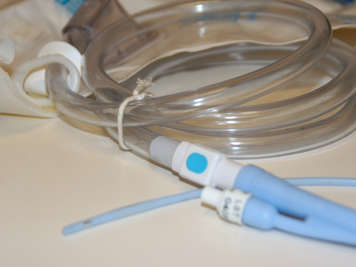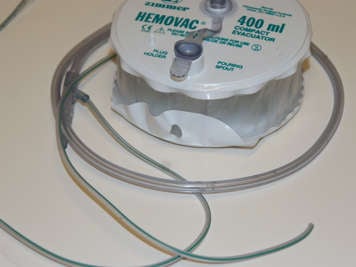Intravenous (IV)

You will have a needle inserted into the back of your hand or in your lower arm when you are in the operating room. It will be attached to an intravenous ( IV) pump which keeps track of the amount of fluids you are receiving. IV fluid is usually made up of a salt solution to help keep you hydrated during and after surgery. IV is also used for giving pain medication or other medication such as antibiotics to prevent infection from surgery.
"At night the IV really bothered me. It was hard to sleep because the cord would get wrapped around everything. Then when I would move, sometimes it would get stuck and would pull my arm."
Arterial line
This is a needle inserted into the inside of your forearm while you are asleep. The arterial line is used to monitor things like blood pressure and take blood samples to measure things like your hemoglobin level. Hemoglobin is a protein in your red blood cells that carries oxygen.
The arterial line will be removed before you are moved from the recovery room or the intensive care unit to your hospital room. The removal of the arterial line may be slightly uncomfortable. However, some teens don’t even remember having one.
Oxygen

You will wake up in the recovery room with an oxygen mask over your mouth and nose. The oxygen is mixed with water to add moisture as oxygen by itself can be very dry. It will feel like a fine mist. The oxygen will help bring you out of the anaesthetic and enable you to breathe easier. The mask does not need to come off in order to talk. Sometimes the nurses may use a tube that runs under your nose and releases oxygen, called nasal prongs, if you find it more comfortable. The length of time you have to wear the oxygen mask will depend on how well you are breathing on your own. This is determined by the oxygen saturation monitor, which is commonly known as the O 2 sat monitor.
Oxygen saturation monitor
The oxygen saturation (O 2 sat) monitor is like a clothespin that can cup over your fingernail or toenail. This monitor measures the amount of oxygen in your blood. It is painless. When it is hooked up to the oxygen saturation machine, your nail glows a pink colour. A sensor will pick up how much oxygen your blood cells are receiving. If your oxygen saturation is the same whether you have your mask on or off, then you do not require the oxygen anymore. However, the oxygen saturation monitor will remain in place while you are on the PCA pump (see below).
"The oxygen saturation monitor doesn’t hurt at all. I didn’t even know it was there at times."
PCA pump
PCA stands for patient-controlled analgesia. Analgesia means pain relief. You will be receiving pain medication continuously through your IV for the first few days after surgery. The PCA pump is also hooked up to your IV and allows you to control the amount of pain medication you receive.
You, and only you, can press the button if you are worried about pain from movement, a procedure, or treatment. Examples might be when the nurses change your back dressing, or when you want to get out of bed. If you are too drowsy to push the button yourself, that means that you don’t need any more medication. It is very important that your parents don’t try to "help" you by pushing the button for you. The PCA pump is computerized so that you cannot overdose on the pain medication. If you have already received the maximum amount of pain medication, you can still press the button but no medication will be released. Most patients will use the PCA pump but some may have morphine infusions as a way to control their pain.
"I didn’t use the pain pump that much because the pain killers they used during the surgery were amazing and lasted long enough for the pain to minimize. The pain pump was convenient to use although I didn’t have to use it that much."
Many patients feel woozy and disoriented while taking the pain medication.
"When I was in the hospital, I was on the pain pump and the morphine gave me the weirdest dreams. I felt like I was actually living the dream and I didn’t realize that I was sleeping. I would wake up and feel really confused."
Heart monitor
You will be hooked up to a heart rate monitor by three wires called leads attached to your chest and lower abdomen by soft sticky sponges. This way your heart rate can be constantly monitored. This is normally used for the first several days after surgery.
"I didn’t even know I was hooked up to it. I knew it was monitoring my heart, but I wasn’t sure how. I think because of the medication I was on, I didn’t really know I had (the leads) on."
Foley catheter

The Foley catheter is a tiny, flexible tube that measures how much fluid your kidneys are flushing out.
The Foley catheter is inserted into your bladder while you are under anaesthetic. It is painless, but when you are awake you may be aware that it is there. It is very important for the anaesthetist to know how much fluid you are receiving and how much fluid your kidneys are flushing out. The catheter is attached to a large bag, called a catheter bag, which accurately measures your urine. The Foley catheter usually stays in place for two to three days. The nurse will remove it by deflating a bulb which keeps it in place, and then sliding it out. The procedure is painless but it may feel irritating.
"I know this isn’t something that everybody would like to hear but I did get a bladder infection from the catheter. I just think people should know that can happen. I just constantly had to pee and it was really annoying."
"I didn’t like the catheter at all. Every time I would move, it would feel awkward. I was really embarrassed to have it just lying around when my friends and family were there. It felt really good to be able to use the bathroom myself. There was a sense of relief when the nurses took out the catheter."
If you are embarrassed about the catheter bag, you can throw a blanket or a towel over it so that your guests won’t see it.
Hemovac drains

A hemovac drain is a tube inserted near your incision to drain any blood collected after surgery. Depending on the amount of drainage, it usually stays in approximately three days.
Chest tube
Depending on the type of surgery you have, you may have a chest tube that is inserted directly into your lung while you are asleep. The chest tube drains the extra fluid from your lungs. This reduces your chance of getting a lung infection and helps your body to heal more quickly following the surgery. The chest tube is usually inserted in between your ribs. The pain medication you are taking will keep it from being too uncomfortable. The chest tube is removed when there is no longer any fluid in your lungs. This usually takes a couple of days.
"The chest tube was very annoying. It was the main reason why I couldn’t leave my room. When it was removed, it wasn’t painful when they pulled it out but it did hurt when they stitched up the hole where it was inserted. It did leave a pretty scabby scar on my side."
Central venous catheter
This particular piece of equipment is used only in very complex cases. This is a needle that is inserted into the side of your neck while you are asleep. This needle is used to give you fluids such as salt and sugar solution, or a blood transfusion during the surgery if needed. Again, it will usually be removed before you are moved from the intensive care unit to your hospital room. It may be slightly uncomfortable when removed. However, it is very likely that you won’t even remember having one.

